Annibale Carracci, Farnese Gallery Ceiling Frescoes
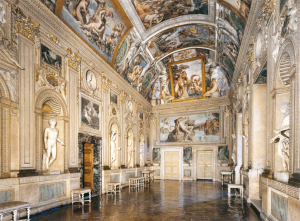
A native of Bologna, Annibale Carracci (1560-1609) received much of his training at an art academy founded there by several members of his family, among them his cousin Ludovico Carracci and his brother Agostino Carracci. The Bolognese academy was the first significant institution of its kind in the history of Western art. The Carracci established it on the premises that art can be taught – the basis of any academic philosophy of art – and that art instruction must include the classical and Renaissance traditions in addition to the study of anatomy and life drawing.
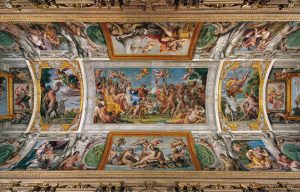
Annibale’s most notable works are his frescoes in the Palazzo Farnese in Rome. Cardinal Odoardo Farnese—a wealthy descendant of Pope Paul III, who built the palace in the sixteenth century—commissioned Annibale to decorate the ceiling of the palace’s gallery to celebrate the wedding of the cardinal’s brother. Appropriately, the title of the fresco’s iconographic program is Loves of the Gods–interpretations of the varieties of earthly and divine love, based on Ovid’s Metamorphoses.
Annibale arranged the scenes in a format resembling framed easel paintings on a wall, but in the Farnese gallery the paintings cover a shallow curved vault. The term for this type of simulation of easel painting for ceiling design is quadro riportato (“transferred framed panel”). By adapting the northern European and Venetian tradition of easel painting to the Florentine and Roman fresco tradition, Annibale oriented the direction of painting in central Italy. He made the quadro riportato format fashionable for more than a century.
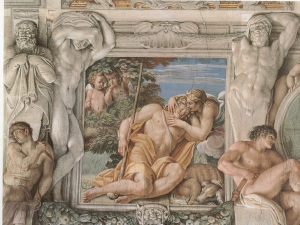
Flanking the framed pictures are polychrome seated nude youths, who turn their heads to gaze at the scenes around them and standing Atlas figures painted to resemble marble statues. Annibale derived these motifs from the Sistine Chapel ceiling, but he did not copy Michelangelo’s figures. Notably, the chiaroscuro of the Farnese gallery frescoes differs for the pictures and figures surrounding them. Annibale modeled the figures inside the panels in an even light. In contrast, light from beneath illuminates the outside as if they were tangible three-dimensional beings or statues lit by torches in the gallery below. This interest in illusion, already manifest in the Renaissance, continued in the grand ceiling compositions of the mature Baroque.
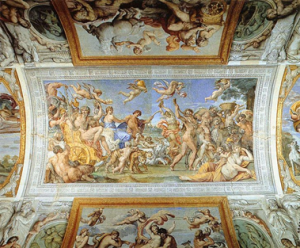
In the crown of the vault, the long panel, Triumph of Bacchus, is an ingenious mixture of Raphael’s drawing style and lighting and Titian’s more sensuous and animated figures. Annibale succeeded in adjusting their authoritative styles to create something of his own—no easy achievement.[1]
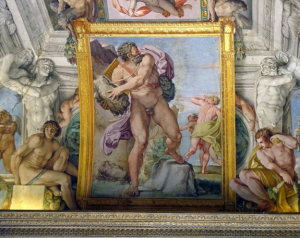
Just as in the Sistine Chapel ceiling, these scenes are painted in fresco on a smooth barrel vault ceiling. Any suggestion of sculpted figures or gilded frames is an illusion – it is all just paint!
- Fred S. Kleiner, Gardner’s Art Through the Ages: The Western Perspective, vol. 2, 15th ed., (Boston: Cengage Learning, 2017), 592. ↵

